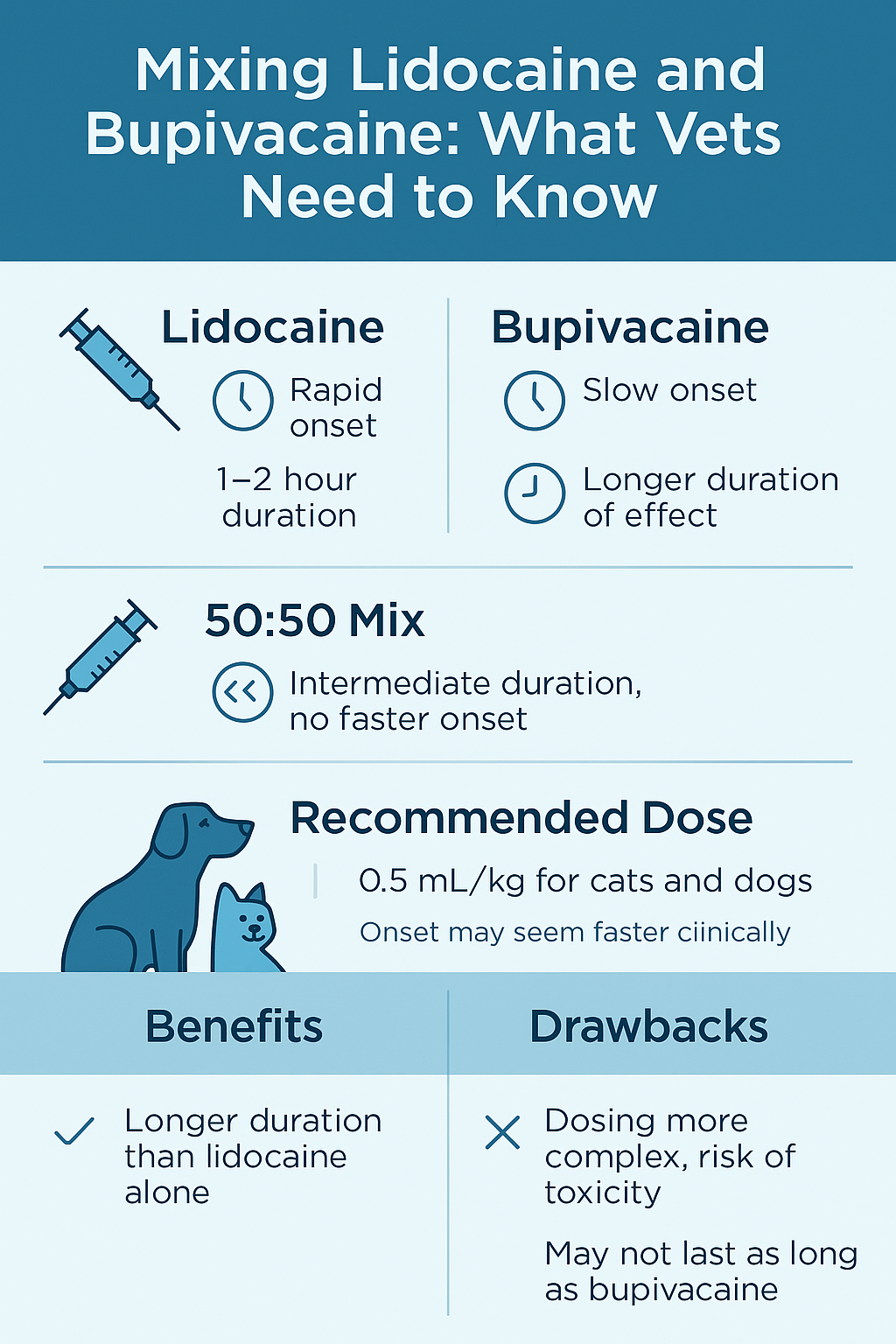
Written by Dr. Tracy Satchell
Mixing lidocaine and bupivacaine is a controversial topic but the idea is simple: lidocaine acts fast, bupivacaine lasts long, so mixing them should give you the best of both worlds.
But does it actually work that way? Let’s find out.
Mechanism of Action
Both lidocaine and bupivacaine are local anesthetics that produce analgesia by blocking sodium channels in neurons, preventing the conduction of nerve impulses. Despite this shared mechanism, their pharmacologic properties differ:
- Lidocaine: Has a pKa around 7.8, meaning at physiological pH (~7.4) most of the drug is non-ionized and can readily penetrate nerve membranes. This contributes to a faster onset of action. Lidocaine is moderately lipid-soluble and less protein-bound, so its duration of action is relatively short (about 1–2 hours for local analgesia).
- Bupivacaine: Has a pKa around 8.1, so less of the drug is non-ionized at body pH, leading to a slower onset (often noticeable 15–30 minutes after injection). However, bupivacaine is highly lipid-soluble and protein-bound, which results in a prolonged duration of action (typically 4–6 hours of local analgesia).
Does mixing improve onset?
According to multiple studies, combining lidocaine with bupivacaine does not significantly speed up the onset* of anesthesia compared to bupivacaine alone. Practically, this means if you administer a 50:50 mix, you should still anticipate an onset of about 15 minutes.
* Author’s Note: Although the research suggests that mixing does not significantly speed up onset, I personally feel like a 50:50 mixture does work much faster than bupivacaine alone.
Does mixing extend duration?
In practice, a mixture will last longer than lidocaine alone, but it will not last as long as bupivacaine alone. In one study, a lidocaine-only block lasted about 2 hours, whereas a 50:50 lidocaine and bupivacaine mix lasted about 4.6 hours.
What does this mean?
The benefit of the lidocaine/bupivacaine mixture is mostly an increase in duration compared to lidocaine alone, which can certainly be useful for short procedures. The downsides include no significant improvement in onset (although some veterinarians beg to differ!) and a shorter duration than bupivacaine alone.
*Note: Bupivacaine is available in 0.5% and 0.25% concentrations. We have used 0.5% throughout this blog.
Dosing Guidelines: Maximum Safe Doses
- Lidocaine: 5 mg/kg (cats), 10 mg/kg (dogs).
- Bupivacaine: 2 mg/kg (cats), 3 mg/kg (dogs).
For simplicity and safety, use cat-safe limits for both species.
Recommended max: 0.5 mL of the 50:50 mix per kg body weight, which delivers 5 mg/kg lidocaine and 1.25 mg/kg bupivacaine.
In Conclusion: Consider Your Goals
If you need a fast, short block, use lidocaine.
If you want long duration and can plan for the delayed onset, use bupivacaine.
If you want a compromise, the mix can work well.
As always, tailor your analgesia plan to each patient, and use the lowest effective doses to keep our canine and feline friends safe and pain-free.
References
Collins J, Song J, Mahabir RC. Onset and duration of intradermal mixtures of bupivacaine and lidocaine with epinephrine. Can J Plast Surg. 2013;21(1):51-53. doi:10.1177/229255031302100112
Pascoe PJ, Dyson DH. Local and regional anesthetic and analgesic techniques: dogs. In: Grimm KA, Lamont LA, Tranquilli WJ, Greene SA, Robertson SA, eds. Veterinary Anesthesia and Analgesia: The Fifth Edition of Lumb and Jones. 5th ed. Wiley Blackwell; 2015:883-903.
Lizarraga I, Chambers JP, Beths T, et al. Evaluation of lidocaine, bupivacaine and a lidocaine-bupivacaine mixture for distal limb nerve blocks in sheep. Vet J. 2013;197(2):515-519. doi:10.1016/j.tvjl.2013.03.026
Lawal FM, Adetunji A. Epidural anaesthesia with lignocaine, bupivacaine and a lignocaine-bupivacaine mixture in cats. J S Afr Vet Assoc. 2009;80(4):243-246. doi:10.4102/jsava.v80i4.194
Keating SCJ, Thomas AA, Flecknell PA, Leach MC. Evaluation of EMLA cream for preventing pain during tattooing of rabbits: changes in physiological, behavioural and biochemical parameters. Res Vet Sci. 2012;93(1):40-46. doi:10.1016/j.rvsc.2011.07.018
DVM360 Staff. I like big blocks and I cannot lie. dvm360. Published March 4, 2020. Accessed July 6, 2025. https://www.dvm360.com/view/i-like-big-blocks-and-i-cannot-lie
Pascoe PJ, Dyson DH. The effects of lidocaine or a lidocaine-bupivacaine mixture administered into the infraorbital canal in dogs. Am J Vet Res. 2016;77(7):682-687. doi:10.2460/ajvr.77.7.682
